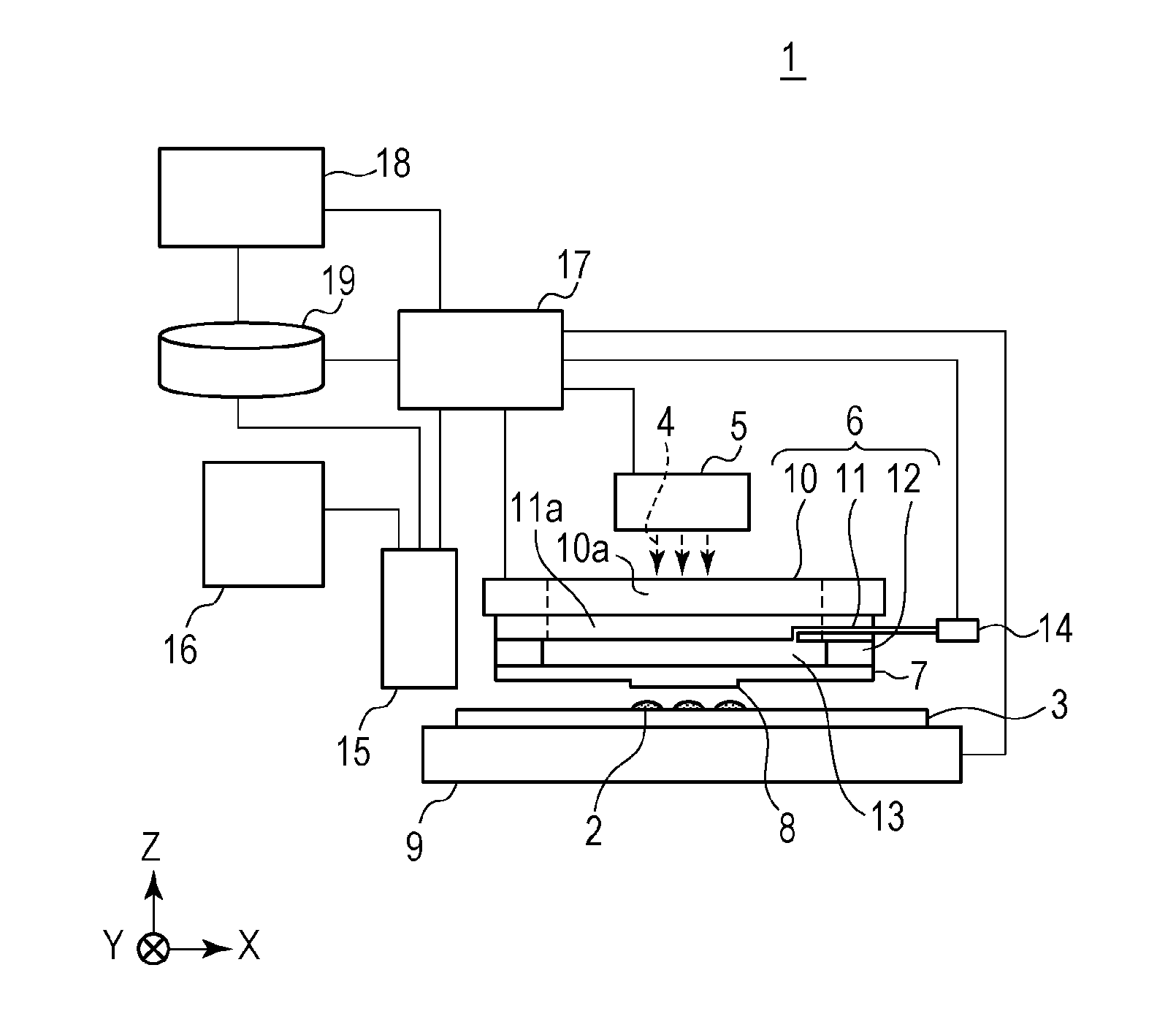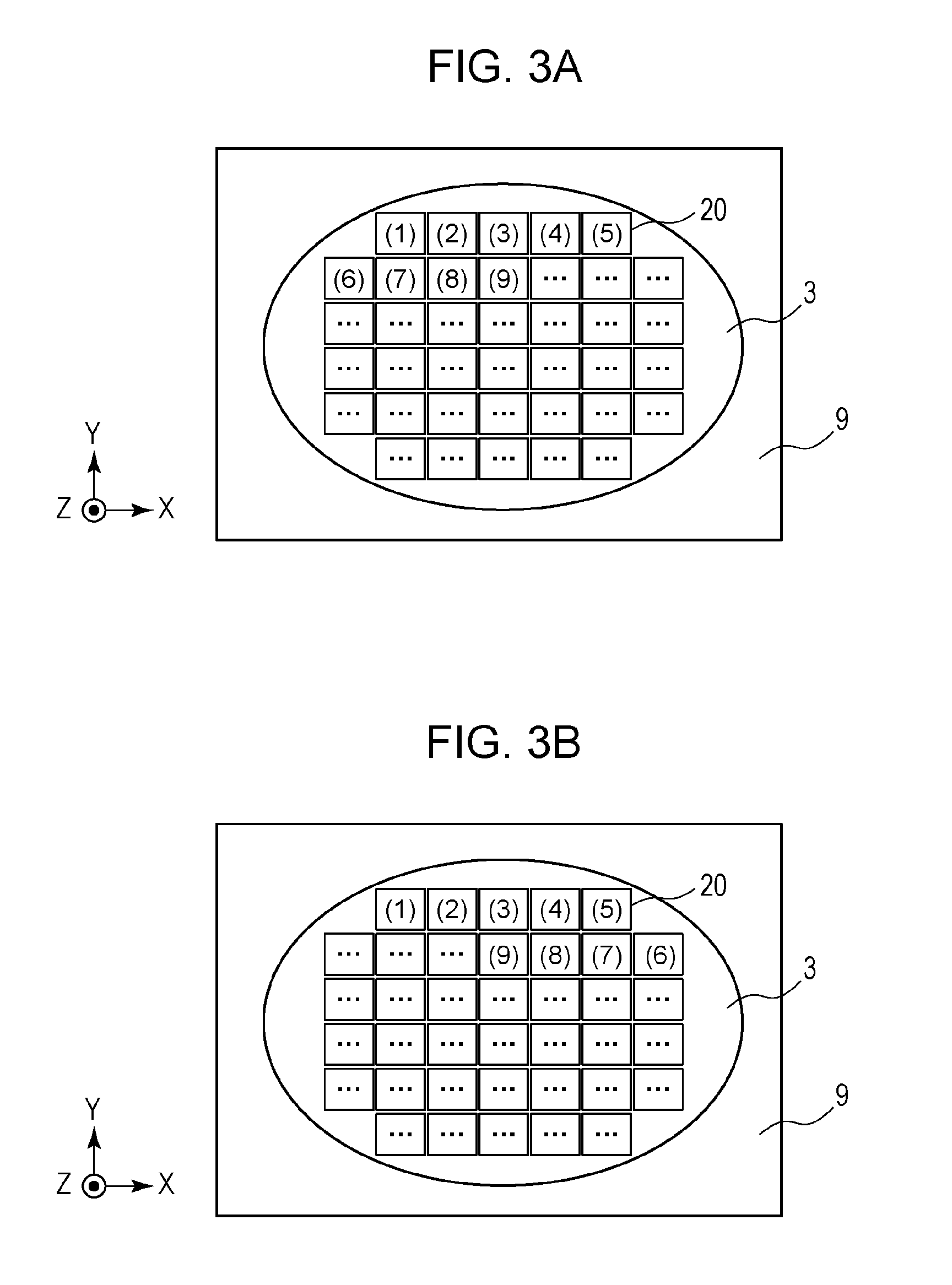Imprinting apparatus, method of creating data on material distribution, imprinting method, and article manufacturing method
- Summary
- Abstract
- Description
- Claims
- Application Information
AI Technical Summary
Benefits of technology
Problems solved by technology
Method used
Image
Examples
first embodiment
Configuration of Apparatus
[0023]FIG. 1 illustrates an imprinting apparatus 1 according to a first embodiment of the present invention. Referring to FIG. 1, a substrate stage 9 carries a substrate 3 such as a wafer and moves along a horizontal plane. The term “horizontal plane” refers to a plane that is perpendicular to the direction of gravitational force. The phrase “to move along the horizontal plane” encompasses a case where the substrate stage 9 moves while inclining with respect to the horizontal plane by a small angle within a range of control error that may occur when the substrate stage 9 is driven. In the first embodiment, a term “information related to the state of imprint material” refers to likely nonuniformity in the thickness of a residual layer 2b (see FIGS. 6A to 6D) included in a pattern formed of imprint material that are estimated from the direction of movement of the substrate stage 9 (the information is hereinafter referred to as “likely residual-layer informati...
second embodiment
[0066]The inclination of the substrate stage 9 at the imprinting position varies with the speed of the substrate stage 9. In a second embodiment of the present invention, the creating unit 18 creates droplet patterns with different levels of nonuniformity in the application density on the basis of the direction of movement of the substrate stage 9, the likely residual-layer information estimated from the direction of movement of the substrate stage 9, and information related to the speed at which the substrate stage 9 moves along the horizontal plane.
[0067]The information related to the speed of the substrate stage 9 is information indicating the level of the speed or the rate of acceleration or the like of the substrate stage 9. Creating droplet patterns on the basis of such information related to the speed of the substrate stage 9 provides a residual layer 2b having substantially uniform thickness, even if the inclination of the substrate stage 9 at the imprinting position varies ...
third embodiment
[0069]Information related to the state of the imprint material 2 according to a third embodiment of the present invention corresponds to the likely residual-layer information or may indicate the state of the imprint material 2 that correlates with the likely residual-layer information and that is observed while the substrate stage 9 is moving. For example, the information related to the state of the imprint material 2 indicates the way the volume of each of the droplets applied to the substrate 3 changes because of volatilization.
[0070]Information related to the order of pattern formation according to the third embodiment corresponds to the order of imprinting: that is, as illustrated in FIGS. 3A and 3B, information indicating in what ordinal number each of the shot areas 20 undergoes pattern formation. The information related to the order of pattern formation may indicate the order of imprinting in a case where patterns are formed on a plurality of shot areas 23 in a single imprint...
PUM
 Login to View More
Login to View More Abstract
Description
Claims
Application Information
 Login to View More
Login to View More - R&D
- Intellectual Property
- Life Sciences
- Materials
- Tech Scout
- Unparalleled Data Quality
- Higher Quality Content
- 60% Fewer Hallucinations
Browse by: Latest US Patents, China's latest patents, Technical Efficacy Thesaurus, Application Domain, Technology Topic, Popular Technical Reports.
© 2025 PatSnap. All rights reserved.Legal|Privacy policy|Modern Slavery Act Transparency Statement|Sitemap|About US| Contact US: help@patsnap.com



